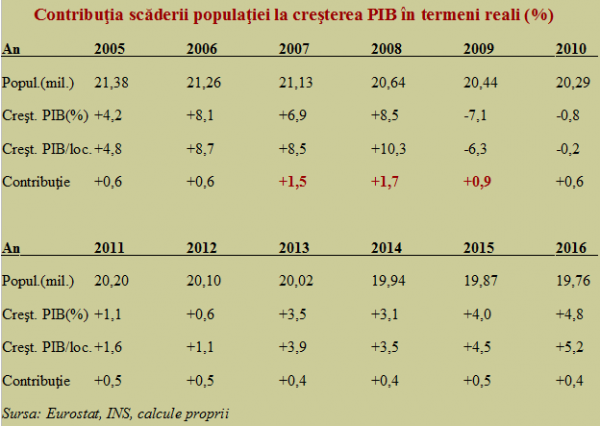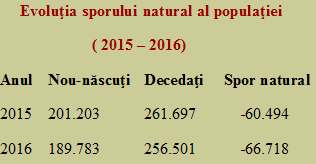 The data published by Eurostat on the evolution of GDP per capita over the period 2005-2015 show that the growth rate of this key indicator for living standards has been boosted, relative to the real economic growth in real terms, by the steady decline of the resident population, which declined (according to the official data) by no less than 1.75 million people in the last 12 years.
The data published by Eurostat on the evolution of GDP per capita over the period 2005-2015 show that the growth rate of this key indicator for living standards has been boosted, relative to the real economic growth in real terms, by the steady decline of the resident population, which declined (according to the official data) by no less than 1.75 million people in the last 12 years.
The addition in the GDP per capita resulted from the year-by-year diminishing of the Romanian population in relation to which is divided the same economic result that is the nominator in the fraction that succinctly describes the welfare in a country fell from 0.6% in the years 2005 and 2006 toward 0.4% now, with an important peak in 2007-2008 and attenuated in 2009, right after the EU accession (see table).
*
- Contribution of the population decrease to the GDP growth in real terms (%)
- Year
- Population (mn)
- GDP increase
- GDP/capita increase
- Contribution
*
Practically, the EU accession and the gradual liberalization (some states opened the employment immigration to Romanians and Bulgarians right after January 1, 2007, others requested transition periods of up to seven years) of the workforce circulation led to the amplification, strictly by this way, of Romania’s GDP/capital by about two and a half percentage points.
This significant contribution to the value with which we relate to the European average living standard per capita is not the result of the economic growth – otherwise consistent, overall, from 2005 onward – but caused by some of those who found no conditions here to perform a decently paid work and left the country.
Of course, the GDP value has been amplified afterwards each year by the money sent to their relatives remained in the country, which have been considered „foreign” investments, increased consumption and stimulated local production, while sustaining the national currency (under the controlled flotation regime), implicitly the stability of the imported products’ prices for those who remained in the country.
Maybe it would have been much better if we had enough jobs and the contribution of those who left to look for work abroad to Romania’s welfare would have been produced inside the country, but it is not clear if their added value to the internal productivity would have been enough to offset the indirect but substantial effect of transferring a part of the value added abroad to the country of origin, where the remuneration of their activity was much higher.
That, without considering the major social problems, with an increased pressure not so much on the workplaces (paradoxically, the departure of some, often the most competent, created space and generated higher salaries for those who remained in the country, where there is already a certain lack of workforce) but especially on dwellings, schools or hospitals.
Domains where the state was no longer pressured to meet new challenges that would have existed if we had an even higher poverty and social non-inclusion rate, a much higher unemployment and an inherently much higher rate of criminality. So, the rush to some extent for the EU accession (January 1, 2010 was a working variant, and it is easy to guess what would have happened if the world crisis had hit us on the eve of the planned accession) prevented us from a whole series of problems.
Back to the relationship between the population decline and GDP, it should be underlined though that NOT the whole decline in the number of inhabitants can be attributed to the departures from the country. Where data show, at January 1, 2017, 19.63 million residents (a small part are foreigners) but 22.20 million people residing in Romania. That is a difference of about two and a half million people.
Beware, a part of the decrease in population, also significant, came from the difference between birth and mortality levels, which started to increasingly clearly take over on the way from the influence of the departures abroad, now contributing around three quarters of the effect of amplifying the GDP per capita, according to the latest INS data.
*
- Evolution of natural growth of population
- Year new-borns deceased natural growth
*
We come this way to the most important long-term effect of departures abroad, beyond the mixed effect resulted from the jobs and relatively low earnings as share in GDP, another issue that should concern decision-makers. That is the QUALITATIVE effect, not the quantitative effect, given that people who left also were to have children, just to provide them with a better future elsewhere.
This way, we can already raise the alarm, given the very rapid decline in births, about twice as fast as the decrease in the number of deaths between 2015 and 2016.
If for the moment, the overall effect is an increase in GDP per capita, it will come very quickly the moment, on the historical scale, when reaching the living standard of the West will practically become impossible. Because there will be no one left to do that, at least from internal sources.











